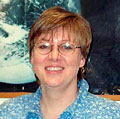 |
|
|
| Author |
Message |
Patty_Cie

Joined: 23 Mar 2004
Posts: 87

|
 Posted:
Tue Jun 08, 2004 6:22 pm Posted:
Tue Jun 08, 2004 6:22 pm |
  |
June 4, 2004 Friday
10:00 PM Alaska time
This has been a special day. At 10:45 this morning, we began a teleconference via INMARSAT satellite phone with my school in Yelm, Washington. Captain Oliver, LCDR Peloquin, Jackie Grebmeier, Lee Cooper, Susan Schonberg, Craig Aumack and I were gathered in the wardroom on deck four. The students were assembled into the Yelm Middle School library. I was surprised and pleased when I was told none of my students were absent.
It was great to hear their voices and their questions. Our allotted thirty minutes flew by and when we said goodbye, I could still hear the excitement in the students’ voices. During our one-hour, evening email window, I received a message that the teleconference sparked a conversation that lasted the rest of the school day.
While the students were debriefing in Yelm, my day on the Healy quickly changed focus. Earlier in the cruise, I wrote in May 18th’s journal entry that I had signed up on a list to assist the ice group. Today was my turn to go and I had to be ready before noon. Therefore, after the teleconference, I grabbed some lunch and rushed to prepare myself for ice deployment. I put on my Mustang suit and boots, packed an extra hat and gloves, stowed my cameras inside my pockets and went to the staging area on the helicopter deck.
All the equipment needed for the day’s sampling was packed into four sleds and secured with tarps and lashings. There is a great deal of equipment because the ice team takes six separate sample sets from the floe.
1. Snow thickness
2. Ice Core temperature measurement
3. Total thickness of sea ice
4. Distribution and concentration of ice algae
5. Primary productivity
6. Under ice measurements
Sleds and people were moved in three transports from the Healy to the ice by a crane hoisting an open cage through the air and gently landing it on the ice. It was a peculiar feeling, hanging and swinging in the air. I was surprised how much I liked it; it reminded me of the flying dreams I had as a child.

It was exhilarating being transported in a manlift. Going from left to right, in the back are Heike Merkel and Rolf Gradinger, Principal Investigator; in the front are Sarah Story and me. Picture by Susan Schonberg.

Waiting on the ground were Kazu Tateyama with two other helpers for the day, Jennifer Sheldon and Dan Schuller and the bear watch. Picture by Susan Schonberg.
When we reached the ice, my first job was to collect snow for Lee Cooper to be used in a project not associated with the ice team. Lee stayed on the Healy, but just before we left, he handed me a 1/4 m2 wood frame, two buckets and explained the sampling procedure. I randomly put the frame down on a flat area of ice and collected all the snow located within the frame’s inside border. I put the collected snow into one of the buckets and resealed the lid. I repeated the procedure on a sloped area of ice, placing the collected snow into the second bucket.
Afterwards, I helped Sarah Story collect samples and record measurements for ice core temperature, total thickness of sea ice (core length), distribution and concentration of ice algae and primary productivity. Sarah is a first year master’s student at the University of Alaska, Fairbanks (UAF) and one of my roommates. She is working for Dr. Rolf Gradinger, assistant professor at UAF. Rolf and Sarah are collecting data to further understand the biological aspects of the sea ice.
We drilled holes into the ice until we reached the water surface. The ice was thick enough that we did the drilling in two sections. Sarah would remove the ice core from the hole and take length and temperature measurements while I recorded. The total ice core length was 192 cm. She worked quickly to avoid ice melt. When the measurements were recorded, Sarah sawed the core into 10 cm segments. She placed each segment into a separate plastic container and put it into an ice chest for transport back to the Healy. The samples will be tested for distribution/concentration of ice algae and primary production activity back on the ship and at UAF as described in my May 18th journal entry.
Sarah used a power drill and an auger to make ice cores.

Sarah measured the temperature of the ice core every 10 cm. I recorded the data. Picture by Rolf Gradinger.
Meanwhile, Rolf Gradinger inserted instruments into the water-filled holes for under ice measurements. He measured the amount and quality of light and the temperature and salinity at the ice/water interface. It was so bright that during part of his measurement recordings, Rolf had to work under his coat so he could see his computer screen.
Rolf also peered into the holes looking for amphipods that live on the bottom of the sea ice. Amphipods look like large fleas ranging in size from 1-5 cm. There are four species of amphipods; three species eat ice algae and one species eat the other three. During an expedition in the summer of 2002, divers were sent under the ice. They took video recordings of the sea/ice interface, and from their pictures, an amphipod density of 1-30 animals per square meter was determined.

While Sarah and I were drilling and removing ice cores, Rolf inserted instruments into the water-filled holes.
Heike Merkel, a second year PhD candidate from the UAF and volunteer, Jennifer Sheldon, drilled four holes in the ice for instruments that will record measurements overnight and be retrieved the next day. Heike is studying the physical aspects of the sea ice under the tutelage of Dr. Hajo Eicken, UAF. In the first hole, they inserted a current meter four meters below the ice/water interface. A current meter was also placed in the second hole, but at a different depth and procedure. It was placed at 50 cm below the interface for one hour, then moved to one meter below for another hour and finally left at the two-meter mark overnight. In the third hole, they placed an instrument to measure the conductivity/temperature/density (CTD) and in the fourth hole, they placed a trap. Usually the trap catches small animals such as amphipods and copepods, but sometimes a fish will be caught. Fish are always returned to the sea.
Heike is interested in the brine channels of the sea ice. It is through these “holes” that water and nutrients are exchanged. Therefore, she tests ice cores for permeability and pore size. She cuts the bottom of the ice core into 5 cm pieces and stores them at –80 degree Celsius. They are taken back to Fairbanks for analysis.

Heike Merkel and Jennifer Sheldon used an auger to make large holes in the ice. They placed instruments in the holes that will stay on the ice floe until tomorrow.
Dr. Kazu Tateyama is an assistant at the Sea ice Research Laboratory, Institute of Low Temperature Science, Hokkaido University, Japan. Traditionally, when scientists have discussed the impact of global warming on the polar ice caps, they have used ice coverage data. Kazu proposes that it also is necessary to measure the ice thickness as well as ice coverage.
Measuring ice thickness is very expensive and in some areas of the polar region, impossible. Satellite imagery provides a more comprehensive, less expensive look at the polar ice thickness. However, while satellite images of ice coverage are very reliable, the present ice thickness images have a large error range. Kazu is on the Healy to collect data he can use to correlate with the satellite data. It is called foot proving. The methods he uses are: hand-drilling holes through ice floes and electro-magnetic sensors. By correlating the ice depths he records on the ocean to the ice depths recorded by the satellites, Kazu hopes to increase the confidence level of the satellite data to a place where it can be used exclusively for worldwide ice thickness measurements.

Kazu Tateyama and Dan Schuller used a hand drill to puncture small holes through the ice. Kazu must measure the thickness of the ice floe in many locations. It was exhausting work and the men took turns drilling the holes. A Coast Guard member stands bear watch.

Kazu’s instrument hangs off the side of the Healy. The electro-magnetic sensor takes ice thickness measurements while we are in transit.
To see photographs taken by Steve Roberts of UCAR/JOSS, click here. |
|
|
    |
 |
|
|
|
View next topic
View previous topic
You cannot post new topics in this forum
You cannot reply to topics in this forum
You cannot edit your posts in this forum
You cannot delete your posts in this forum
You cannot vote in polls in this forum
You cannot attach files in this forum
You can download files in this forum
|
Powered by phpBB 2.0.11
© 2001, 2002 phpBB Group :: FI Theme ::
All times are GMT
| |
